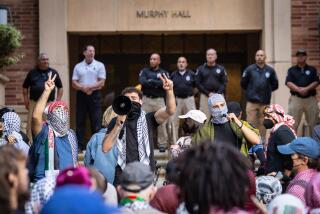Gang Tackling
- Share via
Pete Carroll eases his Mercedes-Benz off the northbound Harbor Freeway, makes a left onto Manchester Avenue and a quick right onto Figueroa Street for a straight, traffic-free ride.
It’s Notre Dame week two years ago, and USC’s football coach is on his early-morning drive to campus.
As he passes the cheap motels, liquor stores and an elementary school along a blighted stretch of South Los Angeles, Carroll is thinking about football until he hears a number that hits him head-on and hard.
It has nothing to do with his team, or the Fighting Irish.
“Seven people were killed over the weekend in gang-related homicides,” the voice on the radio says.
Next day, same route. A similar radio report.
By the end of the week, at Carroll’s count, the number of killings had reached double figures. Sickened, he grabbed his phone and called Lou Tice, an old friend in Seattle.
“You can’t believe what’s happening here.... Kids are dying every day,” Carroll told him. “Let’s make an effort to do something about it.”
Carroll’s call to Tice, a mentor and motivational expert, led to more phone calls. Then invitations. In April 2003, political leaders, high-ranking law enforcement officials and representatives from social service, education and faith-based communities met at USC’s Heritage Hall for a brainstorming session.
That meeting provided the impetus and foundation for what has become “A Better L.A.”, a nonprofit group consisting of a consortium of agencies and organizations working to reduce gang violence by empowering change in individuals and communities.
There are approximately 85,000 gang members and more than 1,110 gangs in Los Angeles County, according to Pete Amico, commander of homeland security for the Los Angeles County Sheriff’s Department. Last year, 586 people died in gang-related homicides.
Carroll said A Better L.A. is working to create “a new normal” by offering peace officers, others working with at-risk youth and, eventually, gang members, “a language of hope.”
The project is focused on some of the neighborhoods Carroll drives through on his way to work.
But, Carroll said, “if you can shift a culture here and prove that you can do it in a place that seems so deeply embedded, you can create momentum for the ability to create change anywhere.”
Carroll and Tice are reluctant to speak about their roles or contributions to the effort. Those on the front line in Los Angeles, they say, do the real work. Police officers and sheriff’s deputies. School administrators and teachers. Social workers, clergy, parents and families.
“I’m just a dang football coach,” said Carroll, who was hired by USC in December 2000.
But Carroll’s prominence as the coach who turned USC’s struggling football program into a national champion was the catalyst that helped bring others together. His charisma and passion for the cause won them over.
“For the depth and breadth of the people in leadership positions who had to come to the table, it could not have happened without someone like Pete Carroll, who did not have a vested interest in his own solution,” said Bea Stotzer, president of New Economics for Women, a nonprofit organization that aids economically disadvantaged families. “It’s easy to get someone to say, ‘OK, let’s go talk. It’s another for someone to say we need to commit to this and make this happen.... He wanted to create the change.”
Carroll’s first step was to call Tice, a natural outgrowth of a relationship that began in 1994 when Carroll became coach of the New York Jets and was searching for a way to change the organization’s culture.
Tice and his wife, Diane, founded the Pacific Institute in 1971. The international corporation has worked with more than 60% of the Fortune 500 companies and has also participated in peace efforts in Northern Ireland, South Africa and Guatemala.
According to its website, “The guiding principle of The Pacific Institute is that individuals, during their lifetime, have a virtually unlimited capacity for growth, change and creativity.... The Pacific Institute curricula teaches how to accelerate individual and organizational potential by changing habits, attitudes, beliefs and expectations that inhibit and often block high-performance people.”
Tice agreed to mentor Carroll and his Jets’ staff.
“I said yes, but the price was going to be that someday when we had a special project in some community that they were engaged in, I was going to call upon them to help me help others in the community,” Tice said.
Turns out, Carroll made the call first.
“He said, ‘We always said we would do something,’ ” Tice recalled. “He said, ‘This is the opportunity right here. Will you assist? Will you help?’ ”
Tice earns thousands of dollars for speaking engagements, and some large corporations pay the Pacific Institute six- and seven-figure fees for training it provides. But Tice has given leadership conferences and provided materials and training for the L.A. effort on a pro bono basis.
Tice said Carroll “creates an environment for his players to play without fear. And that is exactly what we are trying to do for the community in Los Angeles. Allowing them to go about their life -- to teach school without fear, to work without fear, to just drive fear out of the neighborhood.”
Carroll has attended gang intervention conferences in Los Angeles, provided leadership training at places such as Manual Arts High and spoken to at-risk youths after USC practices. He also has taped public service announcements with L.A. County Sheriff Lee Baca and other organization leaders that have incorporated the Pacific Institute’s training.
Sgt. Curtis Woodle, who works for the Los Angeles Police Department’s gang enforcement detail, said his motivation and career were reenergized by Carroll’s involvement.
“I was pretty much dead in the water. I felt overwhelmed,” said Woodle, a 20-year veteran. “For Pete to step out and say, ‘I’m with you guys, tell me what I can do to help you with your issues,’ meant a lot.”
Gary Mann, a sheriff’s deputy who is serving as president of A Better L.A., said nearly 500 people have received training as part of the first phase of the project.
“To change the culture we have to change our culture,” Mann said. “Law enforcement has to realize these kids have potential.... Maybe if we can change the way we talk to them we can help them realize dreams they don’t even know they have.”
The next phase of the project will be training students to train others.
“If there’s going to be a cultural shift, a ‘new normal’ and a common language and attitude on ways approaching and solving problems, then it takes time,” said Ed Robillard, principal at Manual Arts High, who has made the training available to all of his staff. “The thing I’m impressed about is that the Pacific Institute is not coming and saying, ‘This is going to be fixed next week.’ They’re coming in, and they’re going to be here this year and the year after and the year after.”
Cheryl Gourgouris, director of programs for the Richstone Family Center, which deals with child-abuse issues and is involved in gang prevention and intervention in the Lennox area, has seen programs come and go. She is confident this one will be around.
“This is going to grow more slowly and more organically, but there is no doubt in my mind the roots are strongly planted,” Gourgouris said. “I think Pete was very critical in that. ... We never would be able to access this kind of training. It’s a literal gift, and we are thankful.”
On Saturday, top-ranked USC renews its rivalry with Notre Dame, and although Carroll’s short-term focus is to keep his team on track for another national title, he also has an eye cast on the local landscape.
“People need to feel that there is a chance to do stuff, they need to feel the hope,” Carroll said. “So often they feel like they’re up against an immovable force, so when they get motivated and feel directed, then it’s really, really powerful.”
As a football coach, Carroll seeks to nurture leadership from among his players. As a citizen committed to stopping gang violence, he sees positive change potentially coming from an unusual source.
“Imagine the power of the leaders of those groups, the power to risk their lives for the cause,” he said of local gang leaders.
“They must be some incredibly gifted kids to create those kinds of allegiances. If we could ever redirect their energies into positive contributions, we would really have something.”
More to Read
Sign up for Essential California
The most important California stories and recommendations in your inbox every morning.
You may occasionally receive promotional content from the Los Angeles Times.











